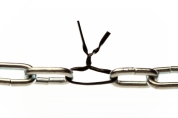Cause and Effect
[originally published in KCN, August 2000]
 “Well Mrs. Jones, I believe I may have found the source of your back pain. From your examination and history, I was able to identify several areas in your spine suffering from the Vertebral Subluxation Complex. This is a condition in which some of the movable bones in your spine (vertebrae) lose their normal motion and position and become fixated or ‘stuck.’ The loss of motion and position of these bones can pinch or irritate the delicate nerve roots that exit between them, causing pain, muscle spasms, inflammation, and faulty nerve transmissions to the rest of your body. In addition, this loss of motion eventually deprives the joints and surrounding tissues of vital nourishment. Consequently, the degenerative effects of arthritis begin to set in.
“Well Mrs. Jones, I believe I may have found the source of your back pain. From your examination and history, I was able to identify several areas in your spine suffering from the Vertebral Subluxation Complex. This is a condition in which some of the movable bones in your spine (vertebrae) lose their normal motion and position and become fixated or ‘stuck.’ The loss of motion and position of these bones can pinch or irritate the delicate nerve roots that exit between them, causing pain, muscle spasms, inflammation, and faulty nerve transmissions to the rest of your body. In addition, this loss of motion eventually deprives the joints and surrounding tissues of vital nourishment. Consequently, the degenerative effects of arthritis begin to set in.
“The good news is that I can help.
“By delivering a series of calculated adjustments to these vertebrae exhibiting the subluxation complex, a more normalized position and quality of motion can be obtained, which in turn, will relieve the stress and tension being placed on the delicate nerve tissue, allowing the symptoms of your back pain to resolve.
“Rehabilitating the areas of the spine afflicted with the Vertebral Subluxation Complex through continued adjustments and specific exercises will aid in restoring the health of your spine, helping you avoid a relapse, and will make your overall treatment more lasting. Most people who maintain some form of regular care, find that not only are they able to stay out of pain more often, but they are able to participate in the activities that they enjoy.”
Definitely not an uncommon report to hear between chiropractor and patient. After all, the Vertebral Subluxation Complex is what we treat — everyday. Doctors of Chiropractic complete extensive schooling and training in order to develop the skills necessary to detect, correct, and manage the condition commonly shortened to just “subluxation.”
A typical question that we chiropractors encounter from our patients is:
“How did I get these subluxations?”

A chain is only as strong as its weakest link.
It’s a very good question. Unfortunately, the answer is a difficult one. You see, the Vertebral Subluxation Complex can be caused by a variety of factors. These factors are usually “stresses” that are placed on our bodies. Any stress that we encounter which is greater than our bodies can handle, will typically zero-in on the “weakened-links” of our spines — resulting in subluxations.
There are three main types of stresses or causes of the Vertebral Subluxation Complex: physical trauma, emotional stress, and chemical imbalance.

Physical Trauma can cause Subluxations.
Of the three causes, physical trauma is probably the easiest to understand and relate to. From day one,our spines are subjected by the often forceful nature of the birth process. As we progress in years, our spines are introduced to new forms of physical trauma such as learning to walk and ride a bike, as well as playing various forms of contact sports. As adults, physical trauma such as automobile accidents, slips and falls, improper lifting, and sleeping on the couch one too many times are common place.
Physical trauma isn’t always a dramatic occurrence though. Many of us are subjected to countless “micro-traumas” that can be just as devastating, or even more so, to the health of our spines. Postural stress while working, especially if it involves repetitive motion over long periods of time, is an example of a microtrauma. These types of traumas are more noticeably in work stations that are of poor ergonomic design.
Emotional influence is a stress that while less tangible than physical trauma can have an equally devastating effect on our spines. Stress, negative thoughts, worry, and emotional upset can manifest themselves in the spine and surrounding muscles. If you’ve ever felt “tense” before a stressful event, then identifying with this cause of the Vertebral Subluxation Complex should make sense. One chiropractic author states that emotional stress plays at least a partial role in 85-95% of all vertebral subluxations.

Emotional Stress can cause Subluxations.
Emotional stresses are manifested in our bodies through our primitive “fight or flight “ survival response. This response causes all of our muscles to forcefully contract in preparation to either fight the threatening force or flee from it. A good visual example of this psychosomatic response is when a cat arches its back in response to a perceived threat. Since we are unable to resolve most of our stressful situations as quickly as our ancestors — by fighting or simply running away — we end up with stresses that wear on us for days, months, or even years, continually triggering the “fight or flight” mechanism. Eventually our overloaded bodies shut down, and the “weak-links” in our spines — determined by our body type or previous episodes of trauma — manifest themselves into the Vertebral Subluxation Complex.

Chemical Imbalances can cause Subluxations.
The most difficult cause of the Vertebral Subluxation Complex to initially grasp is that of chemical imbalances. The truth is, however, the function of the nervous system can be adversely affected by many types of drugs, alcohol, and medication — as can exposure to tobacco smoke, pesticides, a high fat, high protein diet, and environmental pollution and toxins. Nerve transmissions caused by offending irritants in the digestive or respiratory systems, for example, are transmitted to the spinal cord where reflexive signals are sent out to nearby muscles — including those of the deep back attached to the vertebrae. The back muscle contractions on either side of the spine are often of unequal strength, and the persistent tightness that ensues eventually brings about a vertebral subluxation.
So, as you can see, the causes of the Vertebral Subluxation Complex are numerous and tacking down the exact cause requires a little detective work. Most episodes of vertebral subluxations, however, with the exception of blunt trauma, are a combination of the various physical, emotional, and chemical causes. Identifying the main factors of causation in the Vertebral Subluxation Complex will enable you and your Doctor of Chiropractic to effectively manage your condition.
What’s causing your subluxation?
_____________
Sources used for this article:
Cause and effect. (poster). Back Talk Systems Inc. 1994.
Homewood. The neurodynamics of the vertebral subluxation. Chiropractic Publishers. Willowdale, Ontario, Canada. 1962.
Koch. Chiropractic: the superior alternative. Bayeux Arts Inc. Calgary, Alberta, Canada. 1995.
Explore posts in the same categories: adjustment, chiropractic 101, subluxationTags: adjustment, alchol, Anchor Chiropractic, chemical imbalance, chiropractic, chiropractor, depression, Dr. Thomas Lamar, drugs, emotional, emotional upset, falls, grief, health, Kingston, Kitsap, motor vehicle accident, physical trauma, pollution, remorse, repetative motion, second hand smoke, slips, smoking, stress, subluxation, trauma, upset, vertebral subluxation complex
You can comment below, or link to this permanent URL from your own site.
Leave a comment